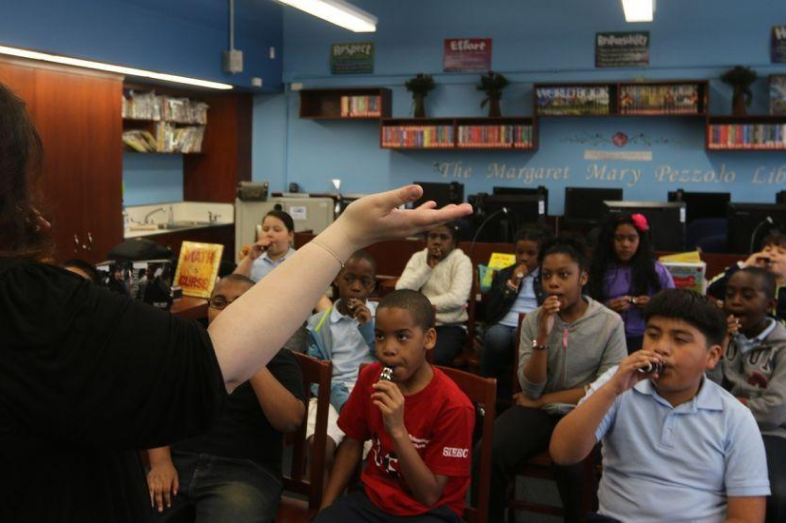
When Artists Visit a Low-Income School to Teach Theater and Music
EWA Radio: Episode 37

EWA Radio: Episode 37
Over the summer The Staten Island Advance published a three-part series about an arts residency program that tasked professional artists to teach elementary school students theater and music – arts instruction that otherwise didn’t exist at PS 57, a largely low-income school in the New York borough. The program was funded by a grant that gave several schools in Staten Island access to artists and supplies.
The timing was bad: Artists met with students twice a week just as the city was gearing up for the high-stakes assessments in math and reading. So the artists worked out arrangements with the teachers to find the space and time to offer the students the chance to act in plays and learn musical instruments.
Lauren Steussy, the writer of the series, joined EWA Radio to talk about her stories.
Steussy notes that the students tackled social justice themes in their drama lessons. She told EWA Radio that the program “chose social justice because the grant was given around the time of Eric Garner and it was a subject that a lot of people were struggling to address.”
The dramatic arc of the play explored bullying and how to mediate conflict, Steussy said. Students wrote parts of the script to more accurately capture the dialogue fourth graders would typically confront in these situations.
Two weeks into the music training, the students were just getting used to making sounds through their instruments. Six weeks later during the recital, Steussy said she was “so astounded that they could learn so many songs.” They mastered their instruments well enough to play three songs after eight weeks and even wrote one themselves with the help of a music teacher. “To see the look on their faces when everyone was applauding, you could tell that they had learned a lot and were proud of themselves for it,” Steussy said.
Often in these stories the reader or listener wants to know if the investment was worth it. Steussy couldn’t point to anything measurable, but through interviews with parents she was told that the students were for the first time excited to go to school. “It’s one of those subtle things that you can’t really measure,” she said.
Without test or attendance data, she can’t know for sure whether the arts translated into boosts in learning across other subjects. “I asked the teachers if they anecdotally saw any improvements, and of course they said yes, but they couldn’t really back it up or anything. It’s hard to prove in a short amount of time, “ Steussy said.
Supporters of arts education say that when done correctly, the arts can be a boon to low-income students. Arts instruction is associated with higher test scores in math and reading, and correlates with higher college attendance rates, according to numerous studies. But Steussy said the arts program at PS 57 seemed larger than that. “The biggest feeling I got wasn’t, ‘Oh, their math scores must’ve improved so much,” she said. “Here are a bunch of kids, just being kids. Their creativity is just insane, they’re so expressive – this is just so natural for them – so why not have them write and perform and learn in a state that’s so natural to them?”
EWA Radio asked Steussy to compare PS 57 to some of the tonier districts she covered while working for the Orange County Register. She said the Staten Island school reminded her of some the poorer schools she visited in California. The students “didn’t expect arts education [at PS 57]; you got the sense that this was something extra that they got to do,” she said. At the wealthier schools in Orange County, “art was a little bit more of a given because that’s what they were used to.”
Find us on iHeartRadio, iTunes, Google Podcasts, Google Play Music, Pocket Casts, Radio.com (app only), Spotify, Stitcher, or through the RSS feed.
Your post will be on the website shortly.
We will get back to you shortly